Introduction
Onigiri is a traditional Japanese snack made from white rice, seaweed, and sometimes fillings such as umeboshi or furikake. It’s a popular snack in Japan, and can be found in convenience stores and supermarkets throughout the country. But is onigiri healthy? In this article, we’ll explore the health benefits of onigiri, as well as its nutritional content and its role in traditional Japanese cuisine.
Analyzing the Nutritional Content of Onigiri
Onigiri is made from simple ingredients, so its nutritional content is relatively straightforward. The primary ingredient in onigiri is white rice, which is high in carbohydrates and low in fat and protein. White rice also contains some fiber, vitamins, and minerals, including magnesium and manganese.
The amount of calories in onigiri depends on the size and type of onigiri. A medium-sized onigiri without any fillings will typically contain around 160 calories, while an onigiri with fillings may contain up to 250 calories. Onigiri is also relatively low in fat and protein, with a single onigiri containing around 1 gram of fat and 2 grams of protein.
Exploring Different Types of Onigiri and Their Health Benefits
There are many different types of onigiri, each with its own unique flavor and health benefits. Here are some of the most common types of onigiri and their health benefits:
Plain Onigiri
Plain onigiri is the most basic type of onigiri, made simply from white rice and seaweed. It’s a good source of carbohydrates and energy, making it a great snack for those who need a quick pick-me-up. Plain onigiri is also low in calories, so it’s a good choice for those watching their weight.
Umeboshi Onigiri
Umeboshi onigiri is made from white rice, seaweed, and umeboshi, a pickled Japanese plum. It has a slightly sour and salty taste, and is a good source of dietary fiber and vitamins. Umeboshi onigiri is also believed to have detoxifying properties, due to the antioxidant compounds found in umeboshi.
Furikake Onigiri
Furikake onigiri is made from white rice, seaweed, and furikake, a dry seasoning mix made from dried fish, sesame seeds, and seaweed. It’s a good source of calcium and vitamin D, which are both important for bone health. Furikake onigiri is also high in sodium, so it’s best enjoyed in moderation.
Vegetarian Onigiri
Vegetarian onigiri is made from white rice, seaweed, and a variety of vegetarian fillings. It’s a good source of plant-based proteins, and can be a great alternative to meat-based snacks. Vegetarian onigiri is also low in calories and fat, making it a healthy option for those looking to lose weight.

Examining the Effect of Onigiri on Weight Loss
Onigiri can be a great snack for those looking to lose weight. It’s low in calories and fat, and provides a good source of energy without the extra calories. Onigiri is also a good source of fiber, which can help you feel fuller for longer and reduce cravings.
However, it’s important to remember that onigiri should only be eaten in moderation. Eating too much onigiri can lead to weight gain, as it’s still high in carbohydrates and calories. To ensure you’re eating a balanced diet, it’s best to pair onigiri with other healthy snacks, such as fruits and vegetables.

Comparing Onigiri to Other Healthy Snack Options
Onigiri can be a healthier alternative to many popular snacks, both in Japan and around the world. When compared to other popular Japanese snacks, such as mochi or tempura, onigiri is generally lower in calories and fat. Onigiri is also a better choice than many Western snacks, such as potato chips or chocolate bars, which are often high in sugar and unhealthy fats.

Investigating the Role Onigiri Plays in Traditional Japanese Cuisine
Onigiri has been a part of Japanese cuisine for centuries. It was traditionally served as part of a bento box, a meal consisting of small dishes of various foods. Today, onigiri is still a popular snack in Japan, and is widely available in convenience stores and supermarkets.
Onigiri is also a popular food for special occasions, such as festivals or weddings. It’s often given as a gift, and is a symbol of goodwill and friendship. Onigiri is also a popular food for picnics and outdoor activities, as it’s easy to carry and doesn’t require utensils or preparation.
Uncovering Common Misconceptions About Onigiri’s Healthfulness
Despite its health benefits, onigiri has been the subject of some misconceptions about its healthfulness. One of the most common misconceptions is that onigiri is an unhealthy food. While it’s true that onigiri is high in carbohydrates and calories, it’s also low in fat and protein, making it a healthier option than many other popular snacks.
Another misconception is that onigiri is a high-calorie food. While it’s true that onigiri can contain up to 250 calories per serving, it’s still lower in calories than many other snacks. Furthermore, the calories in onigiri come primarily from carbohydrates, which are a necessary part of a healthy diet.
Conclusion
Onigiri is a traditional Japanese snack that has been enjoyed for centuries. It’s made from simple ingredients, and is a good source of carbohydrates and energy. Onigiri is also low in fat and calories, making it a great snack for those looking to lose weight. Finally, onigiri is a popular food in Japan, and is often given as a symbol of goodwill and friendship.
(Note: Is this article not meeting your expectations? Do you have knowledge or insights to share? Unlock new opportunities and expand your reach by joining our authors team. Click Registration to join us and share your expertise with our readers.)
